warning light INFINITI G COUPE 2013 Owner's Manual
[x] Cancel search | Manufacturer: INFINITI, Model Year: 2013, Model line: G COUPE, Model: INFINITI G COUPE 2013Pages: 490, PDF Size: 7.25 MB
Page 18 of 490

GUID-5BF1CCAC-1271-471E-83A1-FF109419BE46
SSI0671
1. Side ventilator (P.4-30)
2. Meters and gauges (P.2-6)
3. Center ventilator (P.4-30)
4. Audio system (P.4-41)
5. Clock (P.2-43)
6. Center multi-function control panel—
Navigation system* (if so
equipped)
— Vehicle information and setting
buttons (P.4-9)
— Bluetooth
®Hands-Free Phone Sys-
tem (if so equipped) (P.4-85, P.4-96) —
Audio system (P.4-41)
7. Center display (P.4-3)/Navigation sys- tem* (if so equipped)
8. Hazard warning flasher switch (P.2-39)
9. Front passenger supplemental air bag (P.1-42)
10. Fuse box cover (P.8-24)
11. Parking brake (for Automatic Trans- mission models)
—Parking (P.5-21)
12. Push-button ignition switch (P.5-9)
13. Automatic climate control system (P.4-31)
14. Cigarette lighter and ashtray (if so equipped) (P.2-44) or storage box (if
so equipped) (P.2-50)
—Power outlet (if so equipped)
(P.2-43)
15. Parking brake (for Manual Transmis- sion models)
—Parking (P.5-21)
16. Heated seat switch (if so equipped) (P.2-40)
17. SNOW mode switch (if so equipped) (P.2-42)
18. Rear window and outside mirror (if so equipped) defroster switch (P.2-34)
Illustrated table of contents0-11
INSTRUMENT PANEL
Page 20 of 490

GUID-E8D7EED7-37CE-4B5F-8ECB-479CB10AB8D6
SIC4288
1. Tachometer (P.2-8)
2. Warning/Indicator lights (P.2-12)
3. Speedometer (P.2-7)
4. Engine coolant temperature gauge(P.2-8) 5.
Dot matrix liquid crystal display/
Odometer/twin trip odometer
(P.2-20)
6. Fuel gauge (P.2-9)
Illustrated table of contents0-13
METERS AND GAUGES
Page 22 of 490

GUID-20167C10-9FEC-49A8-BD90-B52F0ED487EA
All-Wheel Drive (AWD) warning
light (AWD models)*2-12
Anti-lock Braking System (ABS)
warning light2-13
Automatic Transmission check
warning light
2-13
Brake warning light
2-13
Charge warning light2-14
Engine oil pressure warning
light 2-14
4 Wheel Active Steer (4WAS)
warning light*
2-14
Intelligent Cruise Control (ICC)
system warning light (orange)*2-15
Intelligent Key warning light 2-15
Low tire pressure warning light 2-15
Master warning light
2-16
Preview Function warning light
(orange)* 2-16
Seat belt warning light 2-17
Supplemental air bag warning
light2-17Warning
light Name Page
Vehicle Dynamic Control (VDC)
warning light 2-17
Indicator light Name Page
Automatic Transmission posi-
tion indicator light* 2-18
Exterior light indicator
2-18
Front fog light indicator light 2-18
Front passenger air bag status
light 2-18
High beam indicator light 2-18
Malfunction Indicator Light
(MIL)2-18
Security indicator light 2-19
Turn signal/hazard indicator
lights2-19
Vehicle Dynamic Control (VDC)
off indicator light2-19
*: if so equipped
Illustrated table of contents0-15
WARNING AND INDICATOR LIGHTS
Page 53 of 490
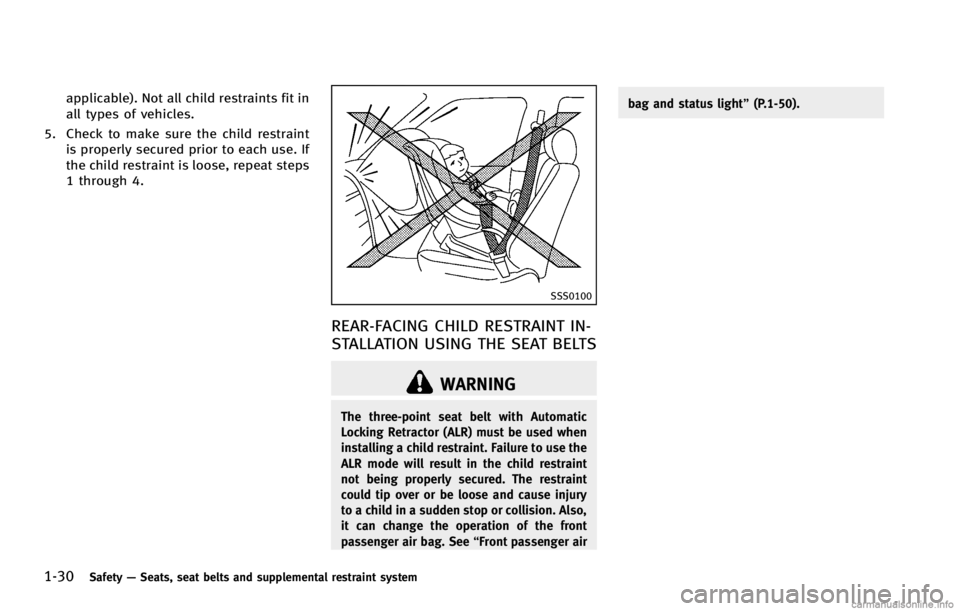
1-30Safety—Seats, seat belts and supplemental restraint system
SSS0100
REAR-FACING CHILD RESTRAINT IN-
STALLATION USING THE SEAT BELTS
GUID-68D5DDB8-3F24-4C65-922C-6DD7B90A7477
WARNING
The three-point seat belt with Automatic
Locking Retractor (ALR) must be used when
installing a child restraint. Failure to use the
ALR mode will result in the child restraint
not being properly secured. The restraint
could tip over or be loose and cause injury
to a child in a sudden stop or collision. Also,
it can change the operation of the front
passenger air bag. See “Front passenger air bag and status light”
(P.1-50).
Page 57 of 490
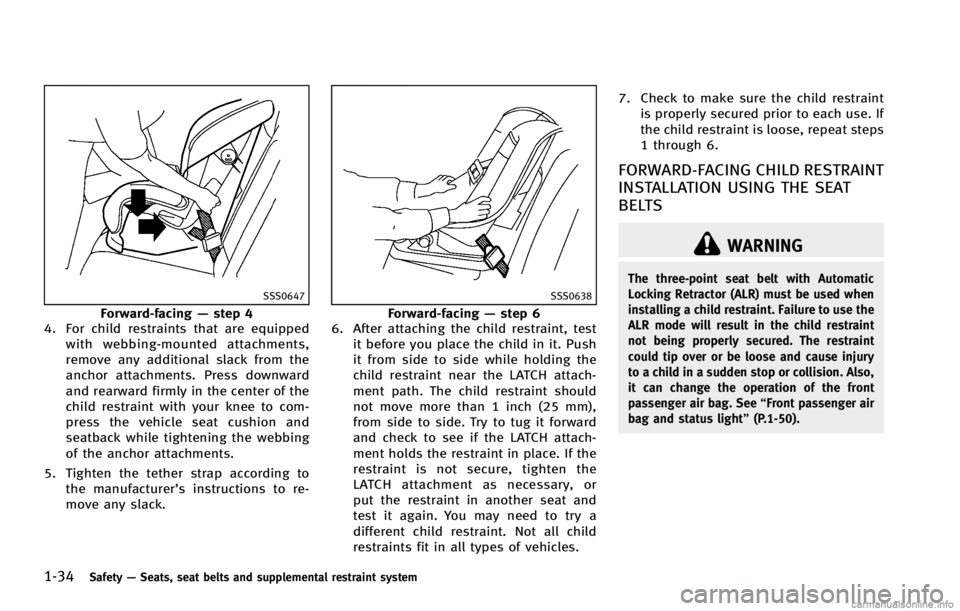
1-34Safety—Seats, seat belts and supplemental restraint system
SSS0647
Forward-facing —step 4
4. For child restraints that are equipped
with webbing-mounted attachments,
remove any additional slack from the
anchor attachments. Press downward
and rearward firmly in the center of the
child restraint with your knee to com-
press the vehicle seat cushion and
seatback while tightening the webbing
of the anchor attachments.
5. Tighten the tether strap according to the manufacturer’s instructions to re-
move any slack.
SSS0638
Forward-facing —step 6
6. After attaching the child restraint, test
it before you place the child in it. Push
it from side to side while holding the
child restraint near the LATCH attach-
ment path. The child restraint should
not move more than 1 inch (25 mm),
from side to side. Try to tug it forward
and check to see if the LATCH attach-
ment holds the restraint in place. If the
restraint is not secure, tighten the
LATCH attachment as necessary, or
put the restraint in another seat and
test it again. You may need to try a
different child restraint. Not all child
restraints fit in all types of vehicles. 7. Check to make sure the child restraint
is properly secured prior to each use. If
the child restraint is loose, repeat steps
1 through 6.
FORWARD-FACING CHILD RESTRAINT
INSTALLATION USING THE SEAT
BELTS
GUID-B0438CCC-C788-4E94-8FA4-DB4F26EE0A33
WARNING
The three-point seat belt with Automatic
Locking Retractor (ALR) must be used when
installing a child restraint. Failure to use the
ALR mode will result in the child restraint
not being properly secured. The restraint
could tip over or be loose and cause injury
to a child in a sudden stop or collision. Also,
it can change the operation of the front
passenger air bag. See “Front passenger air
bag and status light” (P.1-50).
Page 64 of 490

LRS0454
Front passenger position
3. The booster seat should be positioned
on the vehicle seat so that it is stable.
If necessary, adjust or remove the head
restraint to obtain the correct booster
seat fit. If the head restraint is
removed, store it in a secure place. Be
sure to reinstall the head restraint
when the booster seat is removed.
See “Head restraints (front seats)” (P.1-
9) for head restraint, removal and
installation information.
If the seating position does not have an
adjustable head restraint and it is
interfering with the proper booster seat fit, try another seating position or a
different booster seat.
4. Position the lap portion of the seat belt low and snug on the child’s hips. Be
sure to follow the booster seat manu-
facturer’s instructions for adjusting the
seat belt routing.
5. Pull the shoulder belt portion of the seat belt toward the retractor to take up
extra slack. Be sure the shoulder belt is
positioned across the top, middle por-
tion of the child’s shoulder. Be sure to
follow the booster seat manufacturer’s
instructions for adjusting the seat belt
routing.
6. Follow the warnings, cautions and
instructions for properly fastening a
seat belt shown in “Seat belts”(P.1-
14).
SSS0676
7. If the booster seat is installed in the front passenger seat, push the ignition
switch to the ON position. The front
passenger air bag status light
may
or may not illuminate depending on the
size of the child and the type of booster
seat used. See “Front passenger air
bag and status light” (P.1-50).
Safety—Seats, seat belts and supplemental restraint system1-41
Page 66 of 490
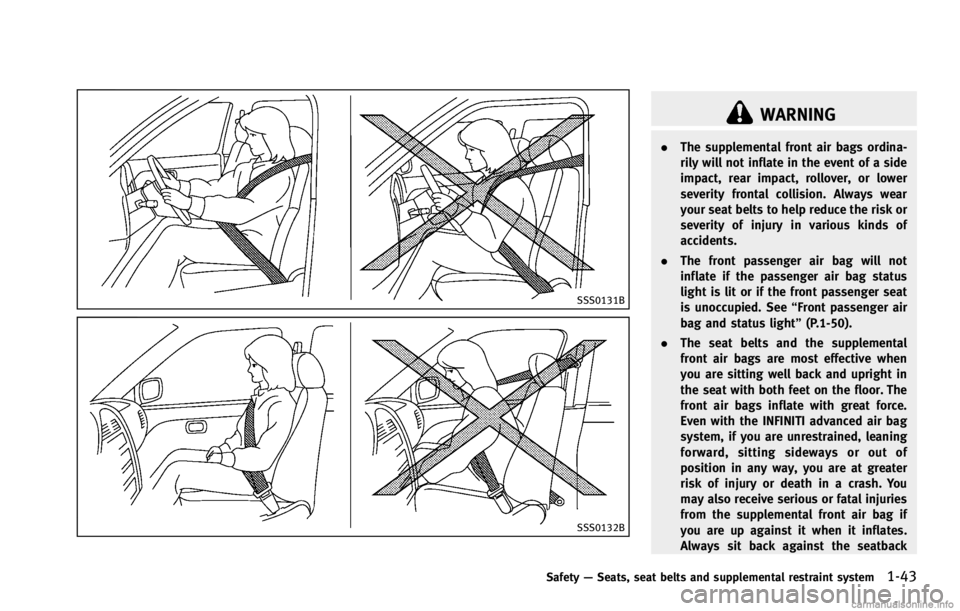
SSS0131B
SSS0132B
WARNING
.The supplemental front air bags ordina-
rily will not inflate in the event of a side
impact, rear impact, rollover, or lower
severity frontal collision. Always wear
your seat belts to help reduce the risk or
severity of injury in various kinds of
accidents.
. The front passenger air bag will not
inflate if the passenger air bag status
light is lit or if the front passenger seat
is unoccupied. See “Front passenger air
bag and status light” (P.1-50).
. The seat belts and the supplemental
front air bags are most effective when
you are sitting well back and upright in
the seat with both feet on the floor. The
front air bags inflate with great force.
Even with the INFINITI advanced air bag
system, if you are unrestrained, leaning
forward, sitting sideways or out of
position in any way, you are at greater
risk of injury or death in a crash. You
may also receive serious or fatal injuries
from the supplemental front air bag if
you are up against it when it inflates.
Always sit back against the seatback
Safety —Seats, seat belts and supplemental restraint system1-43
Page 72 of 490

sensor, the Air bag Control Unit (ACU), seat
belt buckle switches and the occupant
classification sensor (pattern sensor). In-
flator operation is based on the severity of
a collision and seat belt usage for the
driver. For the front passenger, the occu-
pant classification sensor is also moni-
tored. Based on information from the
sensors, only one front air bag may inflate
in a crash, depending on the crash severity
and whether the front occupants are belted
or unbelted. Additionally, the front pas-
senger air bag may be automatically turned
OFF under some conditions, depending on
the information provided by the occupant
classification sensor. If the front passenger
air bag is OFF, the passenger air bag status
light will be illuminated (if the seat is
unoccupied, the light will not be illumi-
nated, but the air bag will be off). (See
“Front passenger air bag and status light”
(P.1-50) for further details.) One front air
bag inflating does not indicate improper
performance of the system.
If you have any questions about your air
bag system, contact an INFINITI retailer. If
you are considering modification of your
vehicle due to a disability, you may also
contact an INFINITI retailer. Contact infor-mation is contained in the front of this
Owner’s Manual.
When a front air bag inflates, a fairly loud
noise may be heard, followed by release of
smoke. This smoke is not harmful and does
not indicate a fire. Care should be taken
not to inhale it, as it may cause irritation
and choking. Those with a history of a
breathing condition should get fresh air
promptly.
Front air bags, along with the use of seat
belts, help to cushion the impact force on
the head and chest of the front occupants.
They can help save lives and reduce
serious injuries. However, an inflating front
air bag may cause facial abrasions or other
injuries. Front air bags do not provide
restraint to the lower body.
Even with INFINITI advanced air bags, seat
belts should be correctly worn and the
driver and passenger seated upright as far
as practical away from the steering wheel
or instrument panel. The front air bags
inflate quickly in order to help protect the
front occupants. Because of this, the force
of the front air bag inflating can increase
the risk of injury if the occupant is too
close to, or is against, the air bag module
during inflation.The front air bags deflate quickly after a
collision.
The supplemental front air bags operate
only when the ignition switch is in the ON
position.
After pushing the ignition switch to the ON
position, the supplemental air bag warn-
ing light illuminates. The supplemental air
bag warning light will turn off after about
7 seconds if the system is operational.
Safety
—Seats, seat belts and supplemental restraint system1-49
Page 73 of 490
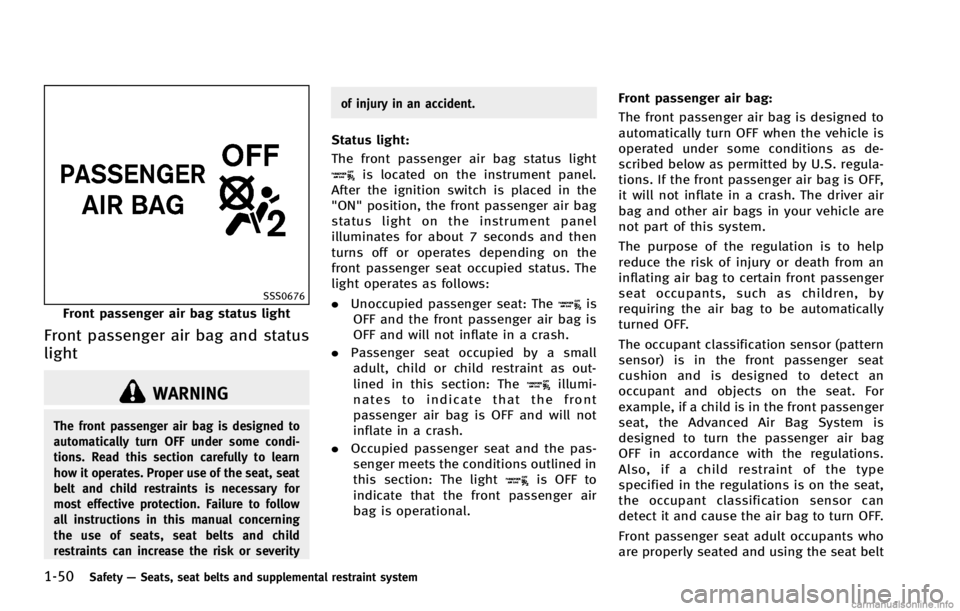
1-50Safety—Seats, seat belts and supplemental restraint system
SSS0676
Front passenger air bag status light
Front passenger air bag and status
light
GUID-F1871FA8-412D-4C8E-B4FC-BB57C13B976F
WARNING
The front passenger air bag is designed to
automatically turn OFF under some condi-
tions. Read this section carefully to learn
how it operates. Proper use of the seat, seat
belt and child restraints is necessary for
most effective protection. Failure to follow
all instructions in this manual concerning
the use of seats, seat belts and child
restraints can increase the risk or severity of injury in an accident.
Status light:GUID-D73A39BF-43C8-459F-9C24-47B7F579C407
is located on the instrument panel.
After the ignition switch is placed in the
"ON" position, the front passenger air bag
status light on the instrument panel
illuminates for about 7 seconds and then
turns off or operates depending on the
front passenger seat occupied status. The
light operates as follows:
. Unoccupied passenger seat: The
is
OFF and the front passenger air bag is
OFF and will not inflate in a crash.
. Passenger seat occupied by a small
adult, child or child restraint as out-
lined in this section: The
illumi-
nates to indicate that the front
passenger air bag is OFF and will not
inflate in a crash.
. Occupied passenger seat and the pas-
senger meets the conditions outlined in
this section: The light
is OFF to
indicate that the front passenger air
bag is operational. Front passenger air bag:
GUID-D73A39BF-43C8-459F-9C24-47B7F579C407
Page 78 of 490
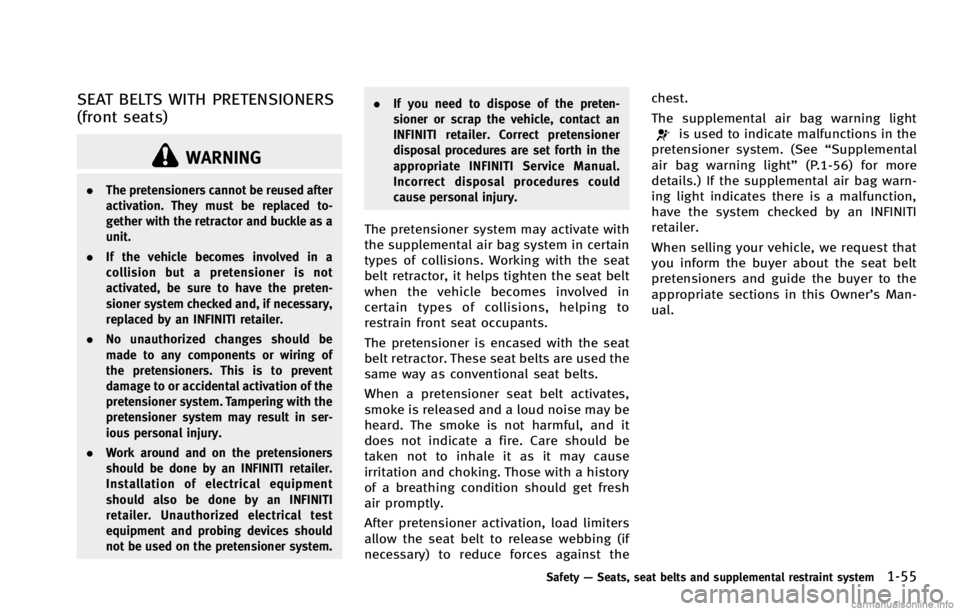
WARNING
.The pretensioners cannot be reused after
activation. They must be replaced to-
gether with the retractor and buckle as a
unit.
. If the vehicle becomes involved in a
collision but a pretensioner is not
activated, be sure to have the preten-
sioner system checked and, if necessary,
replaced by an INFINITI retailer.
. No unauthorized changes should be
made to any components or wiring of
the pretensioners. This is to prevent
damage to or accidental activation of the
pretensioner system. Tampering with the
pretensioner system may result in ser-
ious personal injury.
. Work around and on the pretensioners
should be done by an INFINITI retailer.
Installation of electrical equipment
should also be done by an INFINITI
retailer. Unauthorized electrical test
equipment and probing devices should
not be used on the pretensioner system. .
If you need to dispose of the preten-
sioner or scrap the vehicle, contact an
INFINITI retailer. Correct pretensioner
disposal procedures are set forth in the
appropriate INFINITI Service Manual.
Incorrect disposal procedures could
cause personal injury.
The pretensioner system may activate with
the supplemental air bag system in certain
types of collisions. Working with the seat
belt retractor, it helps tighten the seat belt
when the vehicle becomes involved in
certain types of collisions, helping to
restrain front seat occupants.
The pretensioner is encased with the seat
belt retractor. These seat belts are used the
same way as conventional seat belts.
When a pretensioner seat belt activates,
smoke is released and a loud noise may be
heard. The smoke is not harmful, and it
does not indicate a fire. Care should be
taken not to inhale it as it may cause
irritation and choking. Those with a history
of a breathing condition should get fresh
air promptly.
After pretensioner activation, load limiters
allow the seat belt to release webbing (if
necessary) to reduce forces against the chest.
The supplemental air bag warning light
is used to indicate malfunctions in the
pretensioner system. (See “Supplemental
air bag warning light” (P.1-56) for more
details.) If the supplemental air bag warn-
ing light indicates there is a malfunction,
have the system checked by an INFINITI
retailer.
When selling your vehicle, we request that
you inform the buyer about the seat belt
pretensioners and guide the buyer to the
appropriate sections in this Owner’s Man-
ual.
Safety —Seats, seat belts and supplemental restraint system1-55